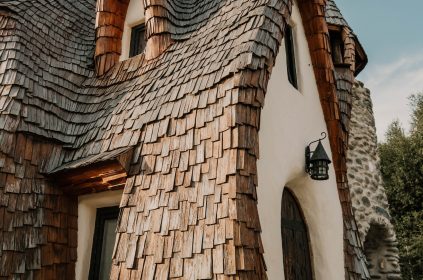Every historical episode is determined by two essential elements: time and space, constant factors that determine its place in the evolution of a human community.
On a rocky road, near Bran, 30 km south of Brasov, the well known Bran Castle is not missing from the itinerary of organized tours in Romania. Being so strongly linked to the legend of Dracula, tourists do not want to miss visiting it. Surely the sinister towers with steep roofs are the right room for a vampire. There are plenty of architectural elements designed to delight a person who likes to kill by shooting.
In reality the connection to Dracula is a bit tenuous, Vlad Tepes, the person on whom Dracula’s legend is based, didn’t even live here, let alone build the castle. It seems that he spent two nights here while fleeing the Turks, or maybe he besieged the castle at some point. Vlad Tepes was ruler of Romania, not Transylvania, so Romania should be associated with Dracula. Incidentally Dracula’s real castle at Poienari gets far fewer tourists than Bran, its 1000 stairs being a hindrance to many.
However despite the lack of Dracula testimonials and an air of horror, Bran Castle is definitely worth a visit. The Roman royal family once lived here and many of the rooms show traces of Queen Mary’s preferences.
The land between Bucegi and Piatra Craiului has determined a series of significant episodes, from prehistory to the present, hosted by a major geographical and historical point: the Branului Pass.
The Bran Gorge, one of the most important trans-Carpathian passages, has had a dynamic history. Its history has been characterized by two major components: the trade routes of its crossroads, and the recurring military invasions that utilized them.
The Bran Pass, one of the most important trans-Carpathian passages, has had a dynamic history. Its history has been characterised by two fundamental aspects: the commercial one, as a crossroads of important routes, and the military one, determined by the recurrent invasions that used these routes.
A natural amphitheatre, defended to the east by the Bucegi Mountains and to the west by the Piatra Craiului Massif, the Bran Pass offered, thanks to its concave shape, a wide panorama, both towards Țara Bârsei and towards the valley and hills of Moeciu.
Originally, Bran Castle was a military defensive construction based on the shape of an irregular quadrangle. Over time, the fortress underwent numerous changes, including: the addition of the south tower (in 1622, according to the plans of Prince Gabriel Bethlen), the construction of a rectangular tower to the east, and between 1883 and 1886, the roof was tiled.
bran castle castlevania dracula fortress vampires
Last modified: November 14, 2022








